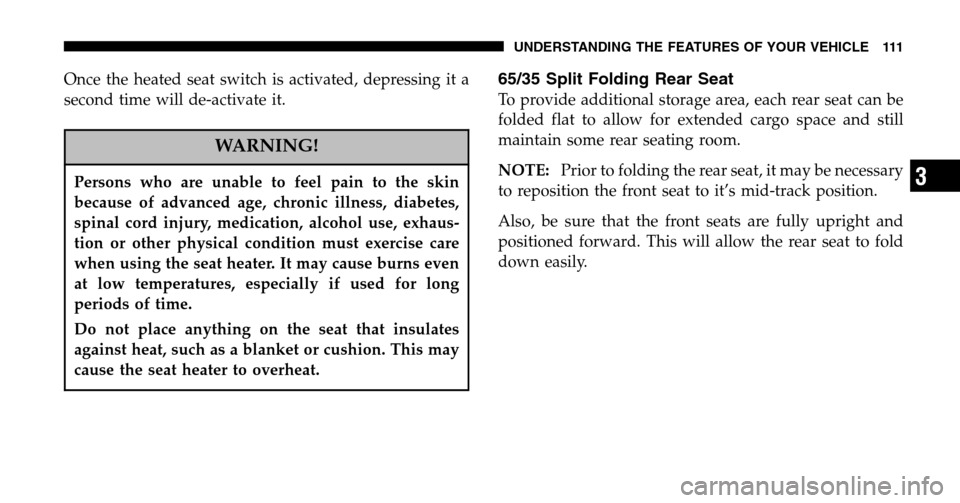Page 72 of 424

A new engine may consume some oil during its first few
thousand miles (kilometers) of operation. This should be
considered as a normal part of the break-in and not
interpreted as an indication of difficulty.
SAFETY TIPS
Exhaust Gas
WARNING!
Exhaust gases can injure or kill. They contain carbon
monoxide (CO) which is colorless and odorless.
Breathing it can make you unconscious and can
eventually poison you. To avoid breathing (CO)
follow the safety tips below.
•Do not inhale exhaust gases. They contain carbon
monoxide, a colorless and odorless gas which can kill.
Never run the engine in a closed area, such as a garage, and never sit in a parked vehicle with the
engine running for a extended period. If the vehicle is
stopped in an open area with engine running for more
than a short period, adjust the ventilation system to
force fresh, outside air into the vehicle.
•Guard against carbon monoxide with proper mainte-
nance. Have the exhaust system inspected every time
the vehicle is raised. Have any abnormal conditions
repaired promptly. Until repaired, drive with all side
windows fully open.
•Always run the climate control in panel or floor mode
when driving with any windows open, even if only
slightly, to help keep fresh air circulating inside ve-
hicle. Otherwise poisonous gases could be drawn into
the vehicle.
72 THINGS TO KNOW BEFORE STARTING YOUR VEHICLE
Page 73 of 424

Safety Checks You Should Make Inside The
Vehicle
Seat Belts
Inspect the belt system periodically, checking for cuts,
frays and loose parts. Damaged parts must be replaced
immediately. Do not disassemble or modify the system.
Seat belt assemblies must be replaced after an accident if
they have been damaged (bent retractor, torn webbing,
pretensioners, etc.). If there is any question regarding belt
or retractor condition, replace the belt.
NOTE: The “Seat Belt Indicator Light” will remain on
until the driver’s seat belt is buckled.
Airbag Warning Light
The light should come on and remain on for 6 to 8
seconds as a bulb check when the ignition switch is first
turned on. If the bulb is not lit during starting, have the
system checked by an authorized dealer.
Defrosters
Check operation by selecting the defrost mode and place
the blower control on high speed. You should feel the air
directed against the windshield.
Safety Checks You Should Make Outside The
Vehicle
Tires
Examine tires for excessive tread wear or uneven wear
patterns. Check for stones, nails, glass, or other objects
lodged in the tread. Inspect for tread cuts or sidewall
cracks. Check wheel nuts for tightness and tires (includ-
ing spare) for proper pressure.
Lights
Have someone observe the operation of all exterior lights
while you work the controls. Check turn signal and high
beam indicator lights on the instrument panel.
THINGS TO KNOW BEFORE STARTING YOUR VEHICLE 73
2
Page 77 of 424

�Electronic Brake Control System ............125
▫ ABS (Anti-Lock Brake System) ............125
▫ TCS (Traction Control System) ............126
▫ BAS (Brake Assist System) ...............127
▫ ERM (Electronic Rollover Mitigation) .......128
▫ ESP (Electronic Stability Program) .........129
▫ ESP/BAS Warning Lamp ................132
� Electronic Speed Control ..................133
▫ To Activate ..........................133
▫ To Set At A Desired Speed ...............134
▫ To Deactivate ........................134
▫ To Resume Speed .....................134
▫ To Vary The Speed Setting ...............134 ▫
To Accelerate For Passing ...............135
� Overhead Console — If Equipped ...........135
▫ Dome/Reading Lights ..................136
▫ Electronic Vehicle Information Center .......137
▫ Customer Programmable Features .........138
▫ Mini-Trip Computer ...................141
� Garage Door Opener — If Equipped .........145
▫ When Your Vehicle Is New ..............146
▫ Programming HomeLink ................147
▫ Gate Operator/Canadian Programming .....150
▫ Using HomeLink .....................150
� Power Sunroof — If Equipped .............151
▫ Express Open Feature ..................152
UNDERSTANDING THE FEATURES OF YOUR VEHICLE 77
3
Page 81 of 424
WARNING!
Vehicles and other objects seen in the right side
convex mirror will look smaller and farther away
than they really are. Relying too much on your right
side mirror could cause you to collide with another
vehicle or other objects. Use your inside mirror when
judging the size or distance of a vehicle seen in the
right side mirror.
Power Remote Control Outside Mirrors — If
Equipped
The controls for the power mirrors are located on the
driver’s door trim panel below the door lock switch.
Set the top switch to the left or right for the left or right
mirror, and set it to the center off position to prevent accidentally moving a mirror when you are finished
adjusting the mirror. Press one of the four arrows for the
direction you want the mirror to move.
Power Mirror Switches
UNDERSTANDING THE FEATURES OF YOUR VEHICLE 81
3
Page 107 of 424
Using body pressure, move forward and rearward on the
seat to be sure the seat adjusters have latched.
WARNING!
•Adjusting a seat while the vehicle is moving is
dangerous. The sudden movement of the seat
could cause you to lose control. The seat belt
might not be properly adjusted and you could be
injured. Adjust any seat only while the vehicle is
parked.
•Do not ride with the seatback reclined so that the
seat belt is no longer resting against your chest. In
a collision you could slide under the seat belt and
be seriously or even fatally injured. Use the re-
cliner only when the vehicle is parked.
Front Seat Adjustment — Recline
To adjust the seatback, lift the lever located on the
outboard side of the seat, lean back, and release the lever
at the desired position. To return the seatback, lift the
lever, lean forward, and release the lever.
Recline Control Lever
UNDERSTANDING THE FEATURES OF YOUR VEHICLE 107
3
Page 109 of 424
Power Seat Adjuster — If Equipped
WARNING!
Do not ride with the seatback reclined so that the
seat belt is no longer resting against your chest. In a
collision you could slide under the seat belt and be
seriously or even fatally injured. Use the recliner
only when the vehicle is parked.
6–Way Power Seat with Manual Recliner
The seat switch is on the outboard side of the seat near
the floor. Use this switch to move the seat up or down,
forward or rearward, or to tilt the seat.
Power Seat Switches
UNDERSTANDING THE FEATURES OF YOUR VEHICLE 109
3
Page 111 of 424

Once the heated seat switch is activated, depressing it a
second time will de-activate it.
WARNING!
Persons who are unable to feel pain to the skin
because of advanced age, chronic illness, diabetes,
spinal cord injury, medication, alcohol use, exhaus-
tion or other physical condition must exercise care
when using the seat heater. It may cause burns even
at low temperatures, especially if used for long
periods of time.
Do not place anything on the seat that insulates
against heat, such as a blanket or cushion. This may
cause the seat heater to overheat.
65/35 Split Folding Rear Seat
To provide additional storage area, each rear seat can be
folded flat to allow for extended cargo space and still
maintain some rear seating room.
NOTE: Prior to folding the rear seat, it may be necessary
to reposition the front seat to it’s mid-track position.
Also, be sure that the front seats are fully upright and
positioned forward. This will allow the rear seat to fold
down easily.
UNDERSTANDING THE FEATURES OF YOUR VEHICLE 111
3
Page 112 of 424
WARNING!
•It is extremely dangerous to ride in a cargo area,
inside or outside of a vehicle. In a collision,
people riding in these areas are more likely to be
seriously injured or killed.
•Do not allow people to ride in any area of your
vehicle that is not equipped with seats and seat
belts.
•Be sure everyone in your vehicle is in a seat and
using a seat belt properly.
To fold the 65/35 rear seat, perform the following
steps:
1. Locate the seatback release handle on the outboard top
side of each rear seatback; lift up on the handle, and
rotate the lever forward until the seatback releases. Fold
the seatback completely forward.
Rear Seat Release
112 UNDERSTANDING THE FEATURES OF YOUR VEHICLE